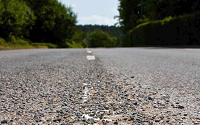Cars of the future need "Readable" roads now
27th November 2013
New cars today do more to protect life than vehicles just 10 years ago, and by 2025, half of the cars on the road in Europe will be capable of “reading” signs and markings. The need for good, consistent signs and markings for drivers remains unchanged since motoring history began. Now vehicles, like drivers, will not function well where road markings and signs are worn out, inconsistent or confusing.

This means putting an end to the different fonts, colours, sizes and shapes that are seen in even the most basic, internationally standardised safety signs such as “stop” and “give way”. It means standardising the width of white lines and the amount of light they reflect – and ensuring the edges of major roads are marked.
“Roads that cars can read”, a report published today by EuroRAP and Euro NCAP, makes important reading for those who maintain Europe’s roads of economic importance. It says that the majority of travel – and road deaths – occur on these roads which comprise just 10 per cent of the network. Inadequate maintenance and differences in road markings and traffic signs are now a major obstacle to the effective use of technology in vehicles, such as lane departure warning and traffic sign recognition.
The report is launched as EU Commissioner for Transport Siim Kallas, FIA President Jean Todt and key stakeholders debate the future challenges of advanced vehicle design at a conference in Brussels today. The “connected” car can provide drivers with access to extensive information about congestion, accidents, road conditions, road works, weather changes and upcoming hazards. It will enable vehicles to communicate with each other and provide warnings, such as unsafe lane departure or immediate risk of collision.
In the foreword to the report, EuroRAP chair John Dawson and Euro NCAP Secretary General Michiel Van Ratingen point out that improved car safety such as crumple zones and airbags has been the single biggest factor in falling road deaths in many countries in Europe in the last decade, but road crashes still result in 300,000 deaths and serious injuries every year, and a 2% loss of GDP.
In launching the report, John Dawson says: “There needs to be a fundamental change in the discipline we apply to road infrastructure. Lane markings are now the ‘rails’ for self-steering vehicles. The safety standards of the rail and aviation industry need to be applied to major roads.” Michiel van Ratingen added: “We set demanding standards for 5-star cars. We must now move towards 5-star roads where the quality of road markings and signs are assured to work with modern vehicles.”
The report calls on the EU, governments and stakeholders to respond to the recommendations of the working party of cross-industry experts who have proposed adopting clear, common standards for road markings and traffic signs on major rural roads which many countries have adopted. The report also calls for an independent survey of Europe’s major roads to assess the scale of action needed to meet these standards.
The report has been welcomed by road users, roads and vehicle manufacturers and road safety organisations.
In an unprecedented statement published for the conference, the FIA, European Road Federation and ACEA (the European Automobile Manufacturers’ Association), representing consumers and roads and vehicle industries join EuroRAP and Euro NCAP in calling for a step-up in road maintenance standards, saying: “Roads that are not regularly maintained cost many times more to repair and reconstruct. Roads that are not properly maintained, marked and signed result in avoidable death, bodily injury and damage. Roads that are unfit for purpose fail to provide the connectivity on which jobs, the economy and society depends.
“Assuring the quality of Europe’s roads must start with the network of greatest social and economic importance. It is unacceptable that this busy network on which so much travel and risk is concentrated should not meet basic standards.”
Notes to editors
The report Roads that Cars can Read: A Quality Standard for Road Markings and Traffic Signs on Major Rural Roads is published jointly by EuroRAP and EuroNCAP with contributions from the FIA, ERF and ACEA has been prepared to inform the Developing Safe, Efficient and Connected Mobility conference.
Based on an overview of existing national practices and research and discussions between consumer associations, safety organisations, vehicle manufacturers and sign and marking industries, EuroRAP and EuroNCAP believe that road markings on Europe’s roads should adopt a simple, memorable “150 x 150” standard already commonly in use. Lane and edge markings should be a consistent 150 millimetres wide, and markings in the dry should reflect light at 150 millicandela.
About Euro NCAP
Euro NCAP organizes crash tests on new vehicles and provides motoring consumers with a realistic and independent assessment of the safety performance of some of the most popular cars sold in Europe. Established in 1997 and backed by several European Governments, motoring, consumer and insurance organizations, Euro NCAP has rapidly become a catalyst for encouraging significant safety improvements to new car design. Visit our website: www.euroncap.com
About EuroRAP
The European Road Assessment Programme (EuroRAP) is an international not for profit association dedicated to saving lives through safer roads. The programme aims to reduce death and serious injury through a programme of systematic testing of risk, identifying the major shortcomings that can be addressed by practical road improvement measures. It forges partnerships between those responsible for a safe road system – civil society, motoring organisations, vehicle manufacturers and road authorities. It aims to ensure that assessment of risk lies at the heart of strategic decisions on route improvements, crash protection and standards of route management.
See www.eurorap.org
Media contact
Hadstrong: Becky Hadley/David Armstrong +44(0)20 7808 7997